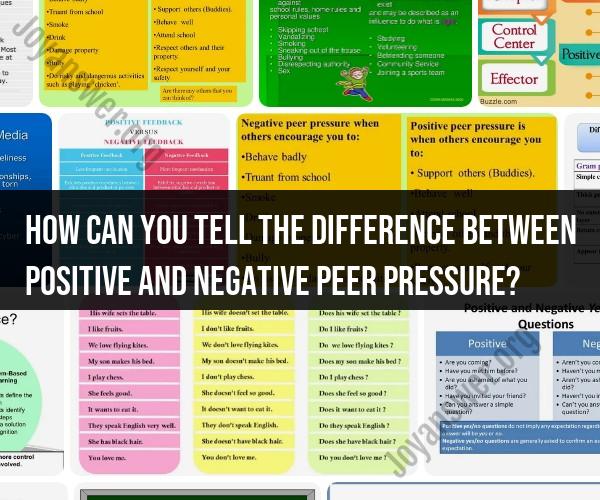How can you tell the difference between positive and negative peer pressure?
Peer pressure is the influence that individuals feel from their peers to conform to certain behaviors, attitudes, or actions. It can be either positive or negative, depending on its impact and outcome. Let's explore the differences between positive and negative peer pressure:
1. Positive Peer Pressure
Definition: Positive peer pressure encourages individuals to make beneficial choices and adopt constructive behaviors.
Examples:
- Encouraging a friend to join a study group to improve academic performance.
- Inspiring someone to pursue a healthy lifestyle by exercising and eating nutritious foods.
- Supporting a peer's decision to engage in community service or volunteer work.
- Motivating a friend to express their creativity through artistic pursuits.
Impact: Positive peer pressure contributes to personal growth, self-improvement, and a sense of empowerment. It fosters healthy relationships and constructive behaviors.
2. Negative Peer Pressure
Definition: Negative peer pressure influences individuals to engage in behaviors that are harmful, risky, or against their values.
Examples:
- Pressuring someone to skip school or engage in substance abuse.
- Convincing a friend to cheat on a test or assignment.
- Encouraging reckless behaviors like speeding or underage drinking.
- Bullying or coercing a peer to conform to harmful social norms.
Impact: Negative peer pressure can lead to negative consequences, compromised well-being, and a sense of regret. It may strain relationships and hinder personal development.
3. Differentiating Factors
Choice: Positive peer pressure respects an individual's autonomy and choices. Negative peer pressure often involves manipulation or coercion.
Consequences: Positive peer pressure leads to positive outcomes and personal growth. Negative peer pressure can result in negative consequences and harm.
Values: Positive peer pressure aligns with an individual's values and aspirations. Negative peer pressure goes against personal values and ethics.
Conclusion
Deciphering positive and negative peer pressure involves recognizing the influence of peers on our decisions and actions. By understanding the distinction between these two types of peer pressure, individuals can make informed choices that contribute to their well-being and personal development.













